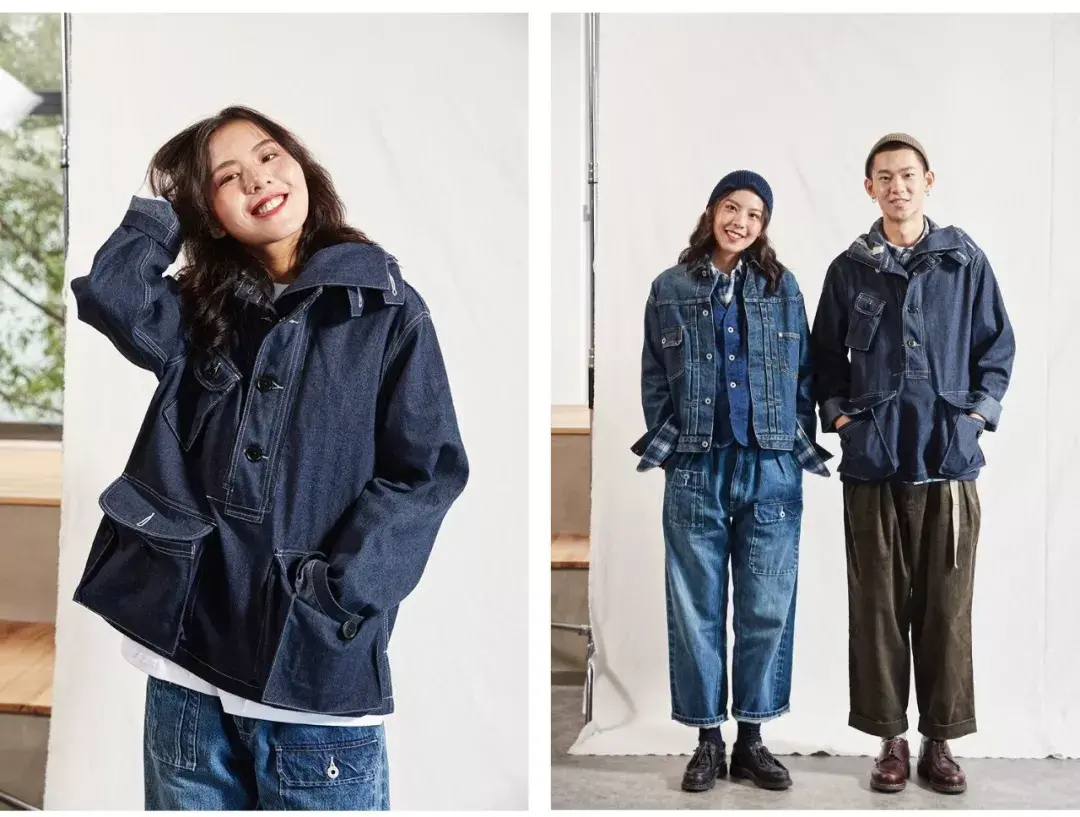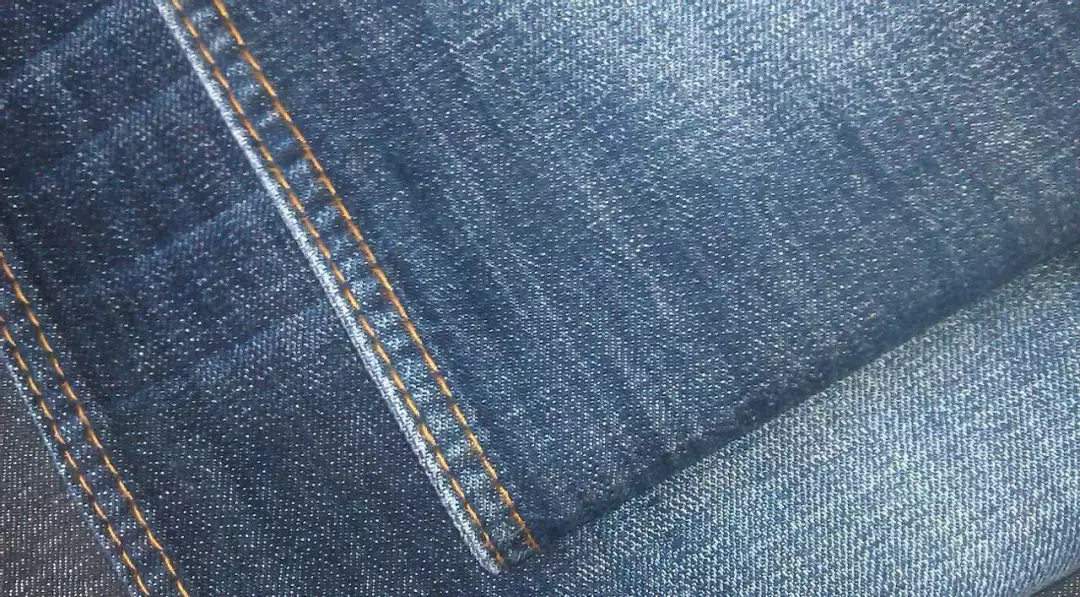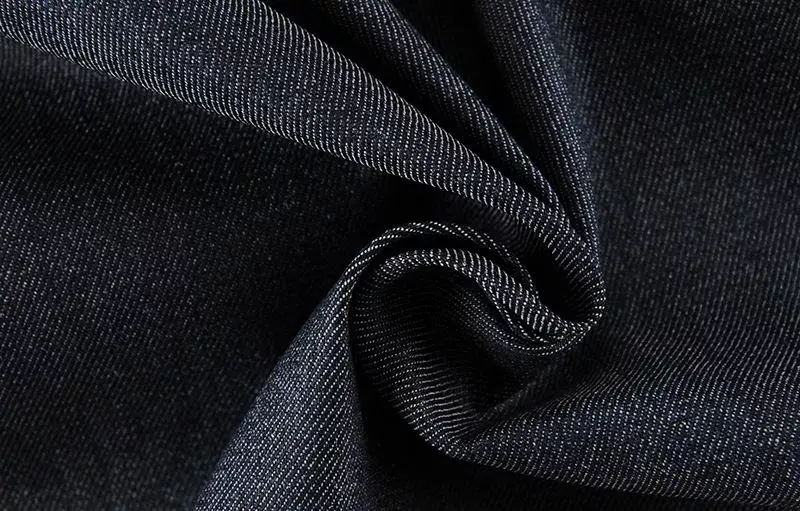Denim is a garment that can be worn all year round. So how to distinguish different types of denim fabrics (denim): First, according to the thickness of denim, it is divided into 4.5A, 6A A, 8 A, 10 A, 11 A, 12 A, 13.5 A, 14.5 A, etc. 4.5 A is very thin and is often used to make women’s vests, sleeveless shirts, etc. in summer, while 14.5 A is very thick and is used for winter. Men’s cotton clothes can be pinned to cotton. Most of the jeans we often wear range from 8A to 12A.

In terms of types of denim fabrics, they can be divided into plain weave, twill weave, herringbone weave, interwoven weave, bamboo, dark weave, and flocked denim, etc. In terms of composition, denim is divided into combed and carded, including 100% cotton, elastic (Lycra), cotton and linen blends, and Tencel. At present, the more popular varieties of denim at home and abroad are mainly ring-spun denim, warp and weft slub denim, super indigo dyed denim, over-color, mixed-color denim and weft stretch denim, etc.
Ring-spun denim
With the high speed and large package of ring spinning With the development and application of new process equipment such as , fine interlocking and knotless yarns, the shortcomings of coarse yarn spinning such as short spinning length, low production efficiency and many knots have been solved. The situation in which the yarn used in denim is replaced by air-spun yarn is rapidly changing, and ring-spun yarn is likely to make a comeback. Because ring-spun yarn denim has some properties that are better than air-spun yarn, such as feel, drape, tear strength, etc., it is also due to people’s psychological return to nature and the influence of the original developed denim style. The more important reason is that environmental protection After the spindle denim clothing is polished and processed, the surface will show a hazy bamboo-like style, whichis in line with the personalized needs of today’s denim clothing. In addition, slub yarn denim is currently very popular in the market, and ring-spun bamboo joints can be spun into shorter and denser bamboo joints, which has also promoted the development momentum of ring-spun denim.

Slub denim
When designing with different yarn numbers and different slubs The slub yarn has a thickness (compared to the base yarn), slub length and pitch, and is equipped with slub yarn in a single warp direction or a single weft direction and both warp and weft directions, and is appropriately matched with normal yarns of the same number or different numbers. When compared and arranged, a variety of bamboo denim can be produced. After washing and processing, various hazy or clear strip-style denim can be formed, which is welcomed by consumers with personalized needs.

Early slub denim almost always used ring-spun slub yarn because it could be spun into shorter lengths, smaller pitches, and higher density. The relatively large slub yarn is easy to form a dense embellishment effect on the cloth surface, and the warp slubs are the main ones. With the development of market consumer demand, two-way slub denim in both warp and weft is currently popular, especially bi-directional slub denim products withweft stretch, which are very popular in domestic and foreign markets. As long as the tissue structure of some varieties is well designed, a single variety of ring-spun yarn can be used in the warp direction and an appropriate proportion of slub yarn can be used in the weft direction, which can also achieve the effect of two-way slub denim in both warp and weft directions.
Weft stretch denim

Spandex elastic silkThe adoption of denim products has developed into a new field. It can make denim clothing close-fitting and comfortable, and then add bamboo knots or different colors to make denim products more suitable for fashionable and personalized consumer needs. Therefore, it has great potential. development potential. At present, most stretch denim has weft elasticity, and its elastic elongation is generally between 20% and 40%. The elastic elongation depends on the weave design of the fabric. The smaller the tightness of the warp and weft weave on the cloth machine, the greater the elasticity. On the contrary, under the condition that the tightness of the warp yarn structure is fixed, the greater the tightness of the elastic yarn in the weft direction, the smaller the elasticity will be. When the tightness in the weft direction reaches a certain level, elasticity may even be lost.
In addition, the current prominent problem of finished stretch denim fabrics is that the shrinkage rate in the weft direction is too large, generally more than 10%, and even up to more than 20% in some cases. Unstable fabric width brings great difficulties to clothing production. The first solution is not to make the elastic stretch too large when designing the product. Generally, it takes 20% to 30%, that is, to maintain a certain tightness in the warp and weft direction, and When pre-shrinking, appropriately increase the tension to cause the fabric to shrink significantly, thereby obtaining a lower residual shrinkage in the weft direction of the finished fabric. Another solution is to heat-set stretch denim after pre-shrinking. In this way, a more uniform fabric width and a more stable and lower weft shrinkage can be obtained, which meets the requirements of garment processing and production.
Special color denim
Due to super indigo dyeing or extra deep indigo dyeing denim The finished garment is wornsex.
5. Chemical Wash (CHEMICAL WASH)
Chemical wash mainly uses strong alkali Additives (NaOH, NaSiO3, etc.) to achieve the purpose of fading, the clothes will have a more obvious stale feeling after washing, and then add softener, the clothes will have a soft and plump effect. If stones are added to chemical washing, it is called fossil washing (CHEMICAL
STONE WASH), which can enhance the fading and wear effects, thereby giving clothes a strong worn-out feel. Fossil wash combines the effects of chemical washing and stone washing, and can achieve an imitation and fluffing effect after washing.
6. Rinse (BLEACH WASH)
In order to make the clothes have a white or bright appearance and soft hand feel, the clothes need to be rinsed, that is, after ordinary washing in clean water, heat to 60°C, and add an appropriate amount of bleach according to the depth of the bleached color.
(bleaching agent),7-10
Make the color match the plate in minutes. During operation, the direction of adding bleach should be consistent with the direction of the rotating cylinder to prevent the bleach from falling directly on the clothes because it cannot be diluted with water as quickly as possible, causing partial bleaching.
Before bleaching, the water level in the tank should be slightly higher to facilitate dilution of the bleaching water. After the clothes are bleached, use large (small) soda (
Na2CO3,
NaHCO3) neutralizes the residual bleach in the water to completely stop bleaching. After it has been washed with clean water, add detergent, fluorescent whitening agent, hydrogen peroxide, etc. to the water temperature of 50°C for final washing, neutralize the PH value, fluorescent whitening, etc., and finally perform softening treatment. Rinsing can be divided into oxygen bleaching and chlorine bleaching. Oxygen bleaching uses the oxidation of hydrogen peroxide at a certain pH value and temperature to destroy the dye structure, thereby achieving the purpose of fading and whitening. Generally, the bleached cloth surface will be slightly red. Chlorine bleaching uses the oxidation of sodium hypochlorite to destroy the dye structure, thereby achieving the purpose of fading. Chlorine bleaching has a rough fading effect and is mostly used for rinsing indigo denim.
After bleaching the boards, sea waves should be used to neutralize the residual chlorine in the water and clothing to stop the bleaching. After bleaching, stone grinding is called BLEACH STONE
7. DESTROY WASH
The process of garments After pumice polishing and additive treatment, certain parts (bones, collar corners, etc.) will be damaged to a certain extent, and the clothes will have a more obvious dilapidated effect after washing.
8. Snowflake washing
Use dry pumice stone The potassium permanganate solution is soaked in, and then polished directly with the clothes in a special rotating cylinder. The pumice stone is used to polish the clothes, so that the potassium permanganate oxidizes the friction points, causing the cloth surface to fade irregularly and form white spots similar to snowflakes. .
The general process of snowflake washing is as follows: Soak pumice in potassium permanganate – Dry grinding of pumice and clothes – Snowflake effect on the board – Take out the clothes for washing Use clean water to wash off the stone dust on the clothes in the water tank – neutralize with oxalic acid – wash with water – apply softener.
9. MOUSTACHE EFFECT
That is, WHISKER, but what WHISKER says Be more professional. Cat whiskers are a type of hand sand (HAND BRUSH), which is just ground into the shape of cat whiskers.
10. Sand blasting is also called sand blast (SPRAY STONE WASH / SAND BLAST)
It uses special equipment (in visual terms, it is a large electric toothbrush, but it is a roller type) to polish the fabric, usually with an inflatable model to match it.
11. MONKEY WASH
The essential difference between it and sandblasting That is, the former is a chemical action and the latter is a physical action. Spray maliu is to use a spray gun to spray potassium permanganate solution onto the clothing according to the design requirements, causing a chemical reaction to cause the fabric to fade. Use the concentration and spray volume of potassium permanganate to control the degree of fading. In terms of effect, Spray Maliu fades evenly, with both the surface and inner layers fading, and can achieve a strong fading effect. Sandblasting only causes fading on the surface, and physical damage to the fibers can be seen.
12. Pigment wash / pigment dyed wash
Also called ” “Single-sided coating/paint dyeing” means that this washing method is specially designed for clothing that has been dyed with paint. Its function is to consolidate the original bright color and increase the softness of the hand.







